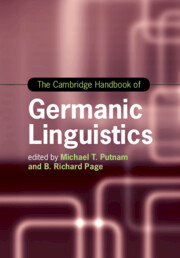Book contents
- The Cambridge Handbook of Germanic Linguistics
- Cambridge Handbooks in Language and Linguistics
- The Cambridge Handbook of Germanic Linguistics
- Copyright page
- Contents
- Figures
- Maps
- Tables
- Contributors
- Acknowledgments
- Germanic Languages
- Part I Phonology
- Chapter 1 Phonological Processes in Germanic Languages
- Chapter 2 Germanic Syllable Structure
- Chapter 3 The Role of Foot Structure in Germanic
- Chapter 4 Word Stress in Germanic
- Chapter 5 Quantity in Germanic Languages
- Chapter 6 Germanic Laryngeal Phonetics and Phonology
- Chapter 7 Tone Accent in North and West Germanic
- Chapter 8 Intonation in Germanic
- Part II Morphology and Agreement Systems
- Part III Syntax
- Part IV Semantics and Pragmatics
- Part V Language Contact and Nonstandard Varieties
- Index
- References
Chapter 2 - Germanic Syllable Structure
from Part I - Phonology
Published online by Cambridge University Press: 31 March 2020
- The Cambridge Handbook of Germanic Linguistics
- Cambridge Handbooks in Language and Linguistics
- The Cambridge Handbook of Germanic Linguistics
- Copyright page
- Contents
- Figures
- Maps
- Tables
- Contributors
- Acknowledgments
- Germanic Languages
- Part I Phonology
- Chapter 1 Phonological Processes in Germanic Languages
- Chapter 2 Germanic Syllable Structure
- Chapter 3 The Role of Foot Structure in Germanic
- Chapter 4 Word Stress in Germanic
- Chapter 5 Quantity in Germanic Languages
- Chapter 6 Germanic Laryngeal Phonetics and Phonology
- Chapter 7 Tone Accent in North and West Germanic
- Chapter 8 Intonation in Germanic
- Part II Morphology and Agreement Systems
- Part III Syntax
- Part IV Semantics and Pragmatics
- Part V Language Contact and Nonstandard Varieties
- Index
- References
Summary
We describe the syllable structure phenomena in modern Germanic languages, mostly in their standardized form – Afrikaans, Danish, Dutch, English, Faroese, Frisian, German, Icelandic, Norwegian, Swedish. The chapter concentrates on consonant cluster phonotactics at various positions in the word and compares the possibilities that languages have in these positions. It turns out that Germanic languages are extremely similar and all seem to use the same basic template with some minor variation.
- Type
- Chapter
- Information
- The Cambridge Handbook of Germanic Linguistics , pp. 33 - 48Publisher: Cambridge University PressPrint publication year: 2020
References
- 1
- Cited by

